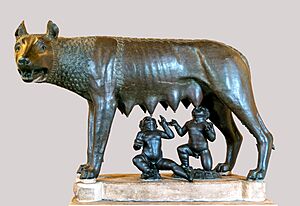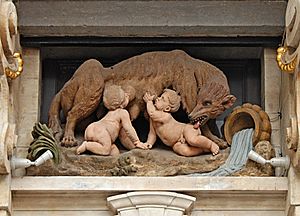Founding of Rome facts for kids


The founding of Rome was a prehistoric event or process later greatly embellished by Roman historians and poets. Archaeological evidence indicates that Rome developed from the gradual union of several hilltop villages during the Final Bronze Age or early Iron Age. Prehistoric habitation of the Italian Peninsula occurred by 48,000 years ago, with the area of Rome being settled by around 1600 BC. Some evidence on the Capitoline Hill possibly dates as early as c. 1700 BC and the nearby valley that later housed the Roman Forum had a developed necropolis by at least 1000 BC. The combination of the hilltop settlements into a single polity by the later 8th century BC was probably influenced by the trend for city-state formation emerging from ancient Greece.
Roman myth held that their city was founded by Romulus, son of the war god Mars and the Vestal virgin Rhea Silvia, fallen princess of Alba Longa and descendant of Aeneas of Troy. Exposed on the Tiber river, Romulus and his twin Remus were suckled by a she-wolf at the Lupercal before being raised by the shepherd Faustulus, taking revenge on their usurping great-uncle Amulius, and restoring Alba Longa to their grandfather Numitor. The brothers then decided to establish a new town but quarrelled over some details, ending with Remus's murder and the establishment of Rome on the Palatine Hill.
Most modern historians doubt the existence of a single founder or founding event for the city, and no material evidence has been found connecting early Rome to Alba or Troy. Most modern historians also dismiss the putative Aeneid dynasty at Alba Longa as fiction. The legendary account was still much discussed and celebrated in Roman times. The Parilia Festival on 21 April was considered to commemorate the anniversary of the city's founding during the late Republic and that aspect of the holiday grew in importance under the Empire until it was fully transformed into the Romaea in AD 121. The year of the supposed founding was variously computed by ancient historians, but the two dates seeming to be officially sanctioned were the Varronian chronology's 753 BC (used by Claudius's Secular Games and Hadrian's Romaea) and the adjacent year of 752 BC (used by the Fasti and the Secular Games of Antoninus Pius and Philip I). Despite known errors in Varro's calculations, it is the 753 BC date that continues to form the basis for most modern calculations of the AUC calendar era.
See also
 In Spanish: Fundación de Roma para niños
In Spanish: Fundación de Roma para niños

